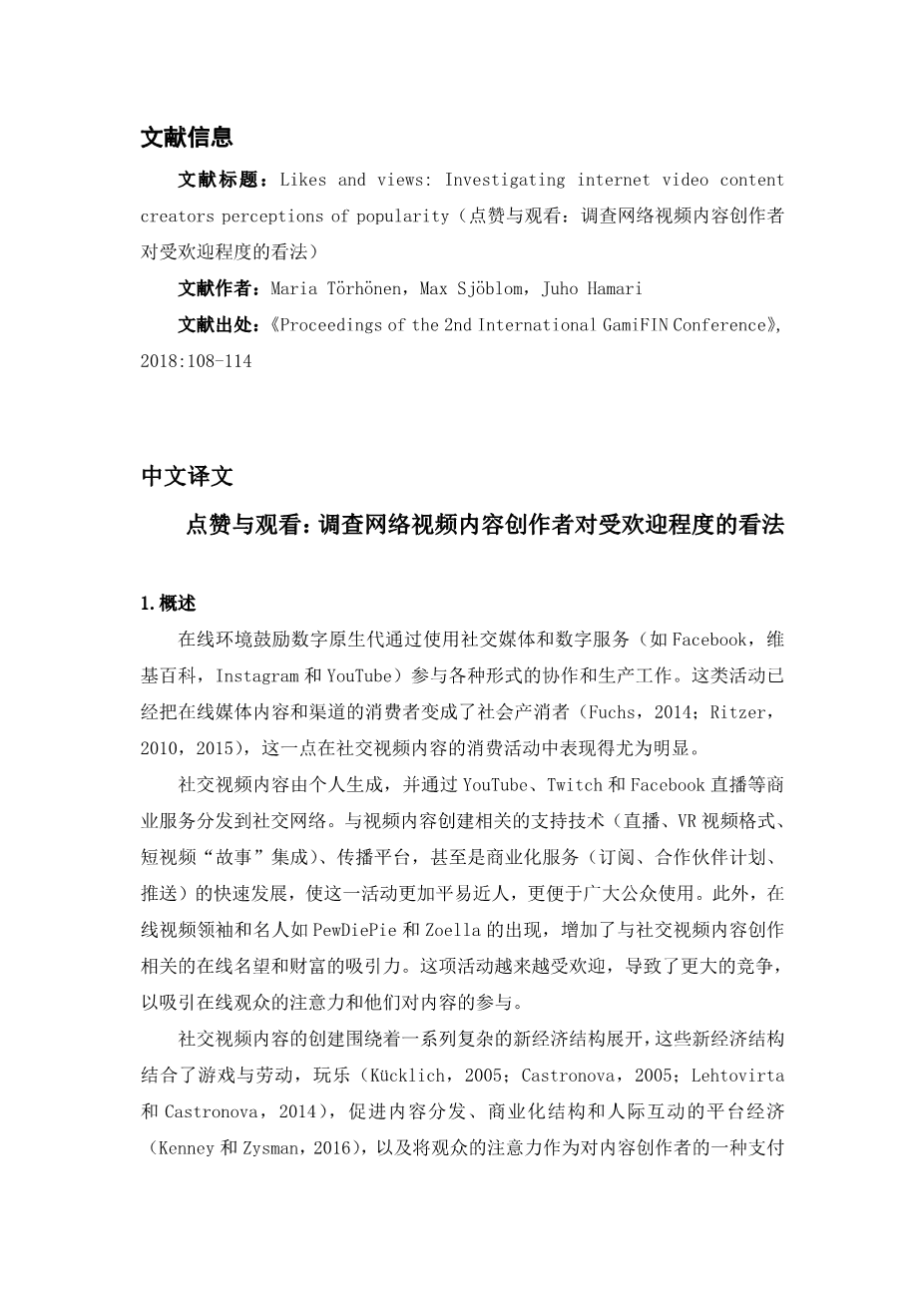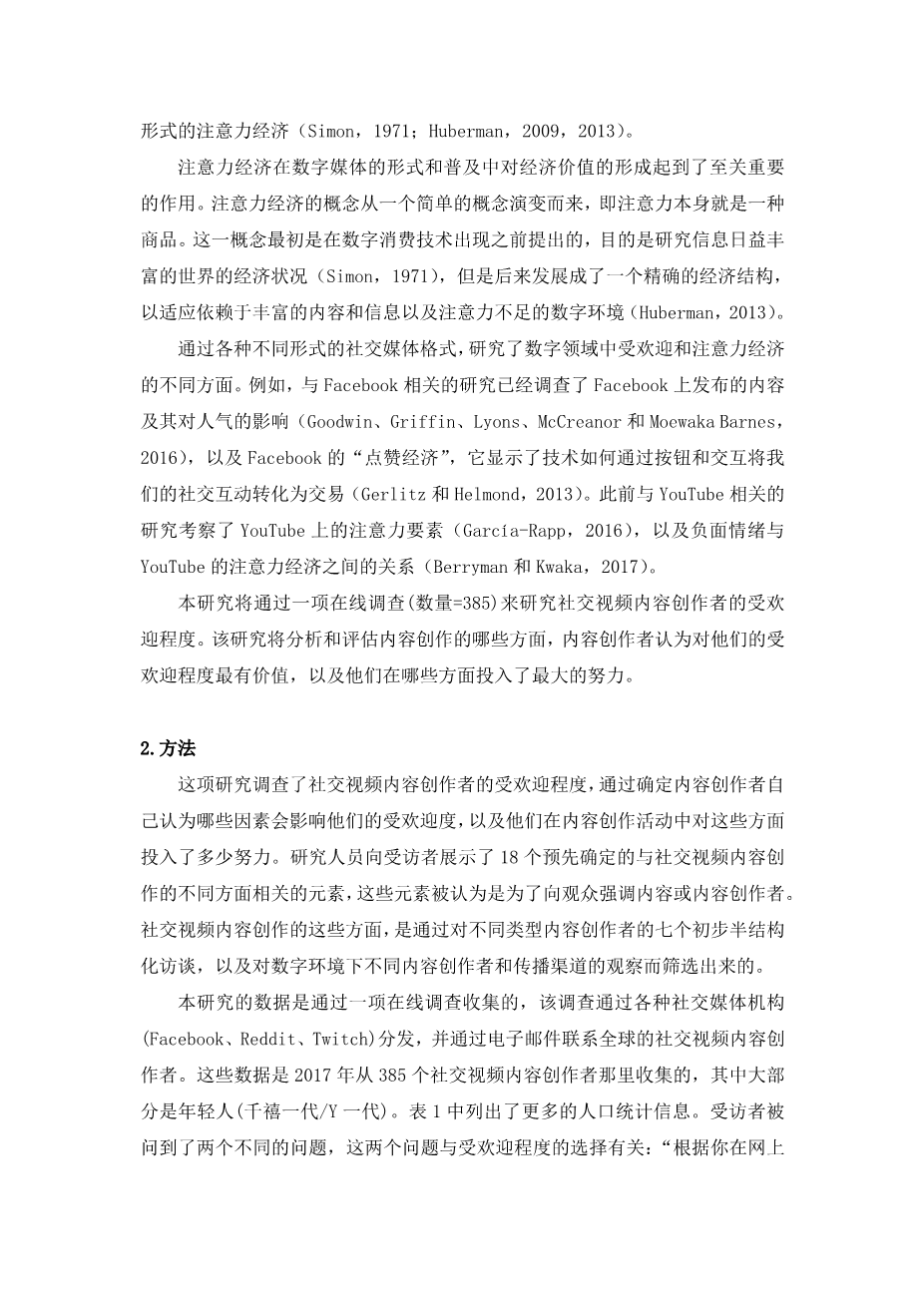文献信息
文献标题:Likes and views: Investigating internet video content creators perceptions of popularity(点赞与观看:调查网络视频内容创作者对受欢迎程度的看法)
文献作者:Maria Touml;rhouml;nen,Max Sjouml;blom,Juho Hamari
文献出处:《Proceedings of the 2nd International GamiFIN Conference》,
2018:108-114
外文文献
Likes and views: Investigating internet video content creators perceptions of popularity
1.Introduction
The online environment encourages digital natives to participate in various forms of collaborative and productive efforts through their use of social media and digital services such as Facebook, Wikipedia, Instagram and YouTube. These type of activities have turned the consumer of online media content and channels into a social prosumers (Fuchs, 2014; Ritzer 2010, 2015), which is particularly evident in the prosumption activities of social video content.
Social video content is generated by private individuals and distributed to social networks through commercial services such as YouTube, Twitch and Facebook live. The rapid developed of supporting technologies (live-streaming, VR video formats, short video “story” integrations), dissemination platforms and even monetisation services (subscriptions, partnership programmes, donations) related to the creation of video content, have made this activity more approachable and available for the general public. Additionally, the emergence of online video influencers and celebrities such as PewDiePie and Zoella, has increased the allure of online fame and fortune, associated with social video content creation. The increase in the popularity of this activity has led to greater competition for the attention of the online audiences and their engagement with content.
Social video content creation revolves around a complicated set of new economic structures that combine both play and labour, playbour (Kuuml;cklich, 2005; Castronova, 2005; Lehtovirta amp; Castronova, 2014), the platform economy, where the platforms facilitates content distribution as well as monetization structures and human interaction (Kenney amp; Zysman, 2016), and the attention economy, where the attention of the viewers acts as a form of payment for the creators of content (Simon, 1971; Huberman, 2009, 2013).
The attention economy has played a crucial part in the formation of economic value in digital media formats and popularity. The idea of the attention economy evolved from a simple notion, that attention itself is a commodity. This idea was first introduced before the emergence of digital consumer technology, to examine the economics of the increasingly information-rich world (Simon, 1971), but developed into an accurate economic structure for the digital environments that depend on the abundance of content and information and the scarcity of attention (Huberman, 2013).
The different aspects of popularity and the attention economy in digital realms have been studied through various different forms of social media formats. For example, studies related to Facebook, have examined the content posted on Facebook and its effects on popularity (Goodwin, Griffin, Lyons, McCreanor amp; Moewaka Barnes, 2016) and the “like economy” of Facebook, that exemplifies how technology, through buttons and interactions, can transform our social interactions into transactions (Gerlitz amp; Helmond, 2013). Whereas previous research related to YouTube has examined the elements of attention on YouTube (Garciacute;a-Rapp, 2016) and how negative emotions are associated with the attention economy of YouTube (Berryman amp; Kwaka, 2017).
This research will examine the aspects of popularity of social video content creators through an online survey (N=385). The research will analyse and evaluate which aspects of content creation, content creators perceive to be most valuable towards their popularity, and which of those aspects they place most effort in.
2.Methods
This research examines the popularity of social video content creators, by determining what content creators themselves perceive to have an effect on their popularity, and how much effort they place on these aspects within their content creation activities. The respondents were presented with eighteen predetermined elements related to different aspects of social video content creation, that were considered to emphasise the content or the content creator to their viewers. These aspects of social video content creation were selected based on seven preliminary semi-structured interviews with different types of content creators, and through observation of different content creators and dissemination channels in digital environments.
The data for this research was collected through an online survey, which was distributed through various social media outlets (Facebook, Reddit, Twitch) and through an email contact list to social video content creators globally. The data was collected during 2017 from 385 social video content creators, out of whom a majority were young adults (millennials/Generation Y). More demographic information presented in Table 1. The respondents were asked two different questions related to the selected aspects of popularity: “Please rate how important you estimate the following things are in regards to the popularity of the videos you share online?” and “How much effort do you put in the following things when producing and sharing videos online?”. Respondents then rated each aspect on a 7-point Likert scale (1 indicating “strongly disagree” and 7 indicating “strongly agree”), which was used to determine the means for each aspect of popularity for the analysis of this research.
Table 1. Demographic information of respondents.
<t
剩余内容已隐藏,支付完成后下载完整资料</t


英语译文共 7 页,剩余内容已隐藏,支付完成后下载完整资料
资料编号:[587910],资料为PDF文档或Word文档,PDF文档可免费转换为Word
|
N |
% |
N |
% |
||||


